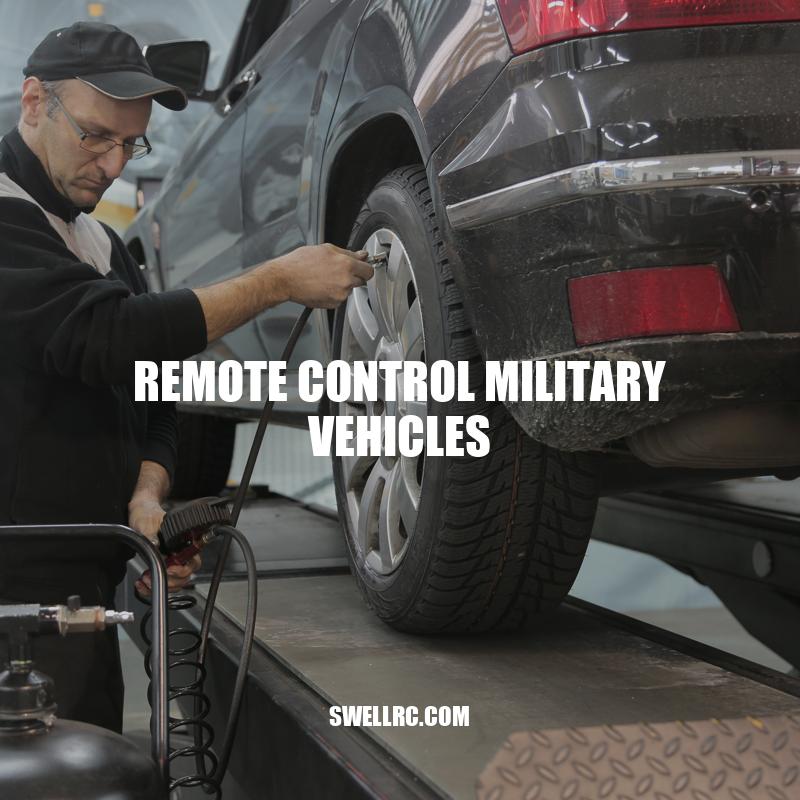Remote Control Military Vehicles: Applications, Types, Challenges, and Future
Remote control military vehicles have been a significant development in modern warfare. They have become an essential asset to the military, performing dangerous tasks that would otherwise put human lives at risk. These vehicles have been used for various purposes such as reconnaissance, surveillance, bomb disposal and neutralization, cargo transportation, and combat. The use of remote control military vehicles has increased in recent years due to their ability to perform tasks that are too dangerous or time-consuming for humans. Their high level of mobility and operational effectiveness in various terrains also makes them a valuable military asset. Remote control military vehicles are classified into four main categories: ground vehicles, aerial vehicles, marine vehicles, and robotic systems. Each type of vehicle has its unique advantages and disadvantages, depending on the intended mission. The future of remote control military vehicle technology looks promising, with advancements in artificial intelligence and autonomy expected to have a significant impact on future operations. However, challenges such as cybersecurity risks and ethical concerns must be addressed before widespread adoption of this technology.
Types of Remote Control Military Vehicles
There are four main categories of remote control military vehicles with unique characteristics, advantages and disadvantages. Understanding these types of vehicles is essential in determining the right vehicle for the mission.
Ground Vehicles
Ground vehicles make up the most common type of remote control military vehicles. Some examples include:
- Wheeled vehicles: capable of high speeds but can face issues in rugged terrain
- Tracked vehicles: can operate in challenging terrains, but have reduced speeds compared to wheeled vehicles
- Legged vehicles: can operate in areas inaccessible to wheeled and tracked vehicles, but limited in speed and stability
Aerial Vehicles
Aerial vehicles can fly or hover to perform various tasks. Some examples include:
- Drones: cost-effective and versatile, but limited payload and flight time
- Helicopters: highly maneuverable and can carry heavier payloads, but limited speed and range
- Airplanes: can fly longer distances and can be fully autonomous, but generally require a longer runway for takeoff and landing
Marine Vehicles
Marine vehicles operate on water and can perform underwater missions. Some examples include:
- Surface vehicles: fast and can transport personnel and equipment, but limited in ocean conditions
- Submarines: can move underwater without detection, but limited by payload, speed, and maneuverability
Robotic Systems
Robotic systems are either ground-based or aerial-based and are used for various purposes. Some examples include:
- Bomb disposal robots: can dispose of explosives without risking human life, but vulnerable to cyber attacks
- Mine detection robots: can find and disable mines quickly and safely, but limited in maneuverability
- Unmanned ground vehicles: can transport equipment and personnel, but limited by battery life and environmental conditions
Overall, understanding the different types of remote control military vehicles is critical in selecting the right vehicle for the mission. Depending on the intended use, the type of vehicle can be selected to maximize operational effectiveness and ensure mission success. Some examples of remote control military vehicles and their uses can be found on websites such as defence.com or army-technology.com.
What are the different types of airborne vehicles?
Airborne vehicles are designed or used for warfare and they can be delivered by air drop, helicopter lift, glider or air landing. Some examples of airborne vehicles include tanks, armored personnel carriers and other combat vehicles. Airborne forces are ground combat units that are carried by aircraft and airdropped into battle zones, commonly by parachute drop or air assault. These forces are also commonly referred to as paratroopers. For more information on airborne forces, visit the Wikipedia page.
Remote control military vehicles have versatile uses in the military, and the list of possible tasks they can perform is extensive. The following are some of the most frequent applications of remote control military vehicles:
- Reconnaissance: Remote control vehicles are used for surveillance, intelligence-gathering, and target acquisition.
- Bomb disposal and neutralization: These vehicles are mainly used in high-risk explosives removal missions.
- Cargo transport: Remote control vehicles can carry food, medical supplies, weapons, or communications equipment to remote or hazardous areas.
- Combat: Military drones and ground vehicles are used to respond to hostile operations.
- Search and Rescue: Remote control vehicles can be used in emergency situations, where hazards may threaten human rescuers.
According to a report by MarketsandMarkets, the market for military robots is expected to grow from USD 13.5 billion in 2020 to USD 30.8 billion by 2025, with ground vehicles accounting for the most significant share. Ground vehicles offer a stable platform capable of carrying out various missions effectively.
One example of a remote control military vehicle that has revolutionized warfare is the Predators drone. The Predator drone is equipped with a long-endurance camera and infrared sensor, making it a critical tool in Intelligence, Surveillance, and Reconnaissance (ISR) operations. The drone can fly up to 25,000 feet and stay in the air for up to 40 hours. On the other hand, the Talon is a remote control vehicle designed for bomb disposal and can climb stairs, enter small areas, and disarm explosives.
Examples of Remote Control Military Vehicles for Specific Tasks
| Task | Type of Remote Control Military Vehicle | Example |
|---|---|---|
| Reconnaissance Operations | Drone | MQ-9 Reaper |
| Bomb Disposal | Unmanned Ground Vehicle | Talon |
| Cargo Transport | Unmanned Ground Vehicle | BigDog |
| Combat Operations | Drone | Switchblade |
| Search and Rescue | Unmanned Aerial Vehicle | Rescue drone |
Understanding the applications of remote control military vehicles, along with emerging technologies, can help militaries better utilize these vehicles to achieve their objectives. Websites such as www.defenseindustrydaily.com and www.military.com provide up-to-date information on the latest developments and products in the remote control military vehicles industry.
What is the application of remote control vehicle?
Remote control vehicles are widely used in law enforcement and military engagements to mitigate the risk of hazard exposure for operators, who can control them from a safe location. Moreover, they are also useful for bomb disposal activities. If you are interested in purchasing a remote control vehicle, there are various websites and products available that cater to different uses and budgets.
Challenges and Risks of Remote Control Military Vehicles
As with any technology, remote control military vehicles come with their set of challenges and risks. It’s essential to understand them and take necessary measures to mitigate them. The following are some of the significant challenges and risks associated with remote control military vehicles:
- Reliability: Remote control vehicles can malfunction, leading to mission failure or severe consequences.
- Cybersecurity risks: The remote controls of these vehicles can be hacked, leading to unauthorized access and control.
- Human factors: Operators may become over-reliant on these vehicles, leading to complacency, reduced judgment, and mission failure.
- Legal and ethical considerations: Remote control vehicles can cause collateral damage, resulting in legal or ethical issues.
Reliability is one of the most significant concerns with remote control military vehicles. In 2007, a drone crashed in Iraq after losing control, killing several US Army soldiers. Cybersecurity presents another risk to remote control military vehicles. In 2011, a virus infected the CreepyDOL surveillance system, which allowed remote operators to track people’s physical locations.
Human factors can be detrimental to the successful use of remote control military vehicles. For example, operators may rely too much on technology and overlook critical details or factors. The legal and ethical issues in the use of remote control military vehicles are also crucial. Collateral damage, civilian casualties, and other unintended consequences can lead to serious legal and ethical implications.
To mitigate these risks, standards and guidelines have been created to govern the use of remote control military vehicles. Websites such as www.dodcio.defense.gov and www.mitre.org provide additional information on the legal and ethical considerations of remote control military vehicles.
What are some disadvantages of military robots?
One of the main disadvantages of military robots is their potential to make unethical decisions during operations, leading to civilian casualties. Without proper restrictions in place, these robots can cause indiscriminate harm and damage to innocent civilians. This issue is particularly relevant in debates around autonomous weapons systems. Interested readers can find further information on such systems and their ethical implications on websites like the Campaign to Stop Killer Robots.
Conclusion
In conclusion, remote control military vehicles have come a long way from their early days as landmine detection tools. They have evolved into highly sophisticated machines that can perform complex tasks in the military, such as surveillance, reconnaissance, and engagement. However, the use of remote control military vehicles also presents its set of challenges and risks, such as reliability concerns, cybersecurity risks, and ethical considerations. To mitigate these risks, proper measures such as regulations, standards, and ethical guidelines must be in place. Nonetheless, their versatility, cost-effectiveness, and effectiveness in military operations make remote control military vehicles an increasingly important asset in modern warfare and peacekeeping missions.
Looking ahead, the future of remote control military vehicles looks promising, with increasing adoption and advancements in technology such as artificial intelligence and breakthroughs like new materials and sensors. Although challenges and risks will remain, continued improvements in the technology and use of remote control military vehicles can only lead to more effective, efficient, and safer military operations.



